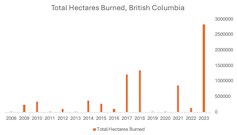Hundreds of firefighters from as far afield as Australia, New Zealand, Mexico and South Africa are being deployed to western Canada to help fight wildfires while a major fire has damaged a third of the structures in the picturesque town of Jasper.
Australian fire managers have arrived in Lac La Biche, Alta. while other experts from Australia and New Zealand were deployed to British Columbia to assist with wildfires there. Meanwhile, over 200 firefighters and two helicopters from Ontario headed to Alberta to lend a hand. But, why do these kinds of exchanges happen and how are they co-ordinated?
The answer to these questions provides some fascinating insights into both the dynamics of Canadian wildfires and the nuances of global disaster relief efforts.
The 2024 Jasper Fire is a grim reminder of the urgency of adopting a Canadian national wildfire strategy
Uneven cycles
Wildfire managers in Canada face a significant problem. In some years, a province will experience massive wildfire activity, while in other years, very little will burn. In a year like 2023, B.C. burned an area more than five times the size of Prince Edward Island — while in 2011, it burned less than three times the equivalent size of the city of Charlottetown.
(Eric B. Kennedy, Author provided (no reuse)
This creates a “peak load problem.” Fire management agencies need to be able to manage the worst of years, but also risk being the target of criticism for being overstaffed or too expensive during quieter ones. Yet, staff need to be hired and trained, equipment needs to be purchased, and aircraft must be procured before the season even begins.
To solve the peak load problem, Canadian fire management relies on a system of mutual aid.
Fire agencies across Canada staff at a roughly appropriate level to the requirements of their ‘average’ fire season and if a province experiences lower-than-average fire loads then they are able to lend personnel and equipment to those that may be experiencing higher than average fire activity. This exchange is typically co-ordinated through a small but essential group of experts within the Canadian Interagency Forest Fire Centre (CIFFC) who co-ordinate potential exchanges between its members.
An exchange begins with the agency in need making a request. This request is transmitted to CIFFC, which looks for availability among the other members. For example, if Alberta needs a waterbombing aircraft that Ontario is willing to share, or if Nova Scotia requires incident management personnel that the Yukon can make available then the CIFFC can help facilitate such efforts.
These exchanges are governed by the Canadian Interagency Mutual Aid Resources Sharing (MARS) agreement which addresses the legal issues, procedures and costs involved in these collaborative efforts. In making a request, the receiving agency agrees to repay the costs of these resources, and in offering to fulfill an order, the sending agency agrees to provide staff and equipment that are up to the standards of the MARS agreement.
Collaborative efforts
CIFFC’s role in fighting fires in Canada is absolutely crucial. Not only does it move thousands of personnel and pieces of equipment per season, but it also helps to ensure firefighting infrastructure is in good working order outside of the fire season.
How do you ensure every hose in the country can connect to every pump, so that it can all be exchanged? How do you ensure that incident management teams will be able to slip into their role seamlessly and work well with counterparts across the country? CIFFC brings member agencies together year-round to negotiate these painstaking details so that pumps from Ontario coming off an airplane in Alberta can immediately be plugged into hoses from Manitoba by firefighters from Saskatchewan.
When Canadian resources are fully exhausted the provinces can also turn to CIFFC to broker international requests. This is done in much the same way: a request is made, CIFFC seeks available resources from international partners and the requesting agency repays the costs.
Some patterns may emerge, such as a tendency to only bring incident managers from expensive destinations like Australia, while bringing more firefighters from closer locales like the United States and Mexico. Moreover, these international exchanges haven’t been without controversy, with recurring disputes around the relative wages paid to international partners being a common theme.

THE CANADIAN PRESS/Darryl Dyck
It is impossible to overstate the degree to which Canada depends on mutual aid — both from within Canada and from around the world — to manage a country increasingly ravaged by wildfires. Fire managers routinely talk about the “Spirit of the MARS,” or the shared commitment in Canada to manage our fires together, and this collaborative spirit is in many ways our greatest asset in the fight against wildfires.
That being said, the mutual aid system is also not without challenges that must be addressed.
One challenge is climate change. As the wildfire seasons lengthen, it will become more and more difficult to draw resources from the southern hemisphere. As fires drag into Australian autumns and emerge earlier in Canadian springs, it will become more difficult to rely other countries during their traditional quiet periods. Additionally, as the fire load rises across the whole country and whole season, it becomes harder to find resources in quiet times elsewhere within the country.
As wildfires become more frequent and intense, how will persistent smoke exposure affect long-term health?
These pressures mean that it’s critical every member agency continues to increase their capacity as their fire load increases, rather than relying only on other provinces to backfill. The variability of the “peak load” problem will continue, but as the wildfire season grows, Canada’s provinces and territories will need to be prepared not just for their own needs but to be on hand to help their fellow Canadians as well.
Unexpected benefits
Canada depends on mutual aid to manage its fire. Moreover, mutual aid brings all sorts of other benefits.
Mutual aid in firefighting efforts build trusted relationships and professional exchanges as firefighters collaborate across the country. The very practical exchange of learning, knowledge, and experience beyond what a firefighter could ever hope to acquire working within their province alone is itself a huge asset to Canadian firefighting efforts.
Confronting the challenge of a future in flames requires investing in the “Spirit of the MARS,” and continuing to lean on mutual aid rather than attempting to go it alone.




